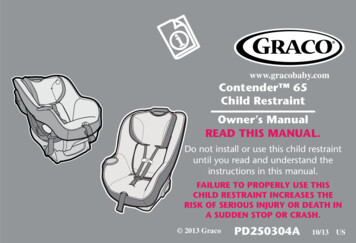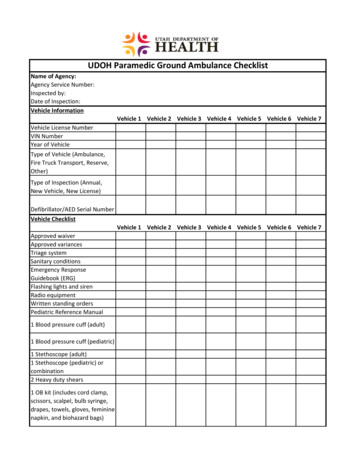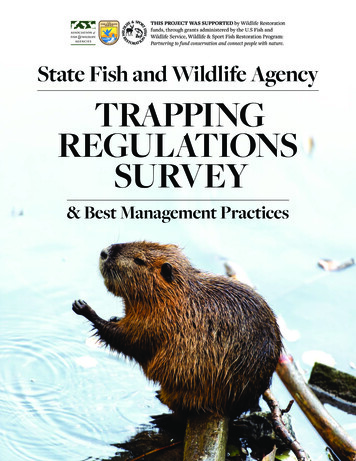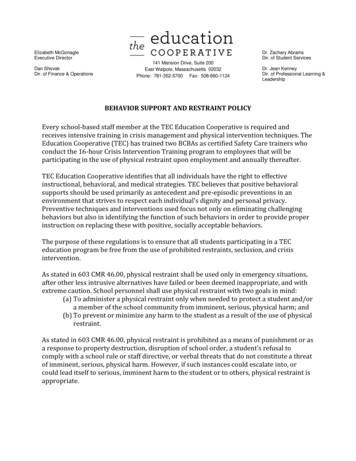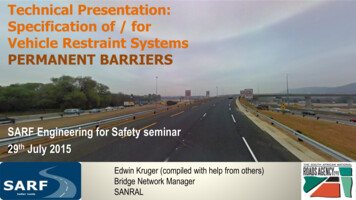
Transcription
Technical Presentation:Specification of / forVehicle Restraint SystemsPERMANENT BARRIERSSARF Engineering for Safety seminar29th July 2015Edwin Kruger (compiled with help from others)Bridge Network ManagerSANRAL
Types of Vehicle Restraint SystemsFlexible:WIRE ROPESemi-Rigid:GUARDRAIL andCONCRETERigid:CONCRETE
Flexible – Wire Rope – TypesParallelWoven
Semi-Rigid Steel TypesW-ShapeSteel Barrier / Guard RailDouble height steelBarriers
Concrete BarriersPre-CastMovable Semi-RigidCast-in-situ or Pre CastRigid
Barriers and Crash tested barrier systems in permanent installations?
PERMANENT BARRIERS What are we used to?What specifications do we follow?What vehicles are we trying to restrain?What are the traffic conditions?What is the speed of traffic?ORDo we just follow “what has always been done”? 90% of allengineers at this stage if one hazards a guess.
“W” Beam Guardrail as seen on all of our roads
In most cases our “W” Beam Guardrail system worksKeep in mind that some severe accidents occur a fairly safelocations . Can not cater for each and every situation
Standard “W” beam guardrail after heavy impact(could be wooden or steel posts same result)Just a thought. What caused the accident? Looking at advertmounted in bridge ahead? Difficult to prove but a possible causeby loss of concentration. Pressurised by commercial interestsand other vested interests without considering road safety
WHAT IS NCHRP? We have talked about but not detailed NCHRP, so just a bit ofhistory relating to this acronymNCHRP, the National Cooperative Highways Research Programwas established in the 1960s by AASHTO and the FHWAThis is “backed” by the Transport Research Board of the NationalAcademies and each NCHRP report that is issuedIs reviewed by a committee of the TRB and the National ResearchCouncil
What is National Cooperative Highway Report 350 is all about
Specifications New National Standard SANS 51317 – parts 1 and 2 Aligned with EN 1317 Containment level Working widthMUST be a CRASH TESTED system NCHRP testing can be equated whereappropriate.
Design Never mix specifications with design Specifications compliment design but per se are not designs It is incumbent on designers to know the mechanisms ofbarrier systems and what they can and can not do. Simplystating that guardrails must comply with a specification is notadequate. Designers should know the basics.
Design considerations What speed is my traffic moving at? What is the likely angle of impact? What vehicle size is most common? How much working space do I need? How much deflection can I allow?
Design guidelinesVery little is readily available in South AfricaThere are very good guidelines available using “Mr Google” but dotake care. Be careful of supplier driven solutions. Look atinternational literatureYES we need to develop design guidelines for specifying guardrailsor barriers.
Now for some background to SANS 51317It is a specification that compliments design.One needs to understand the background to containment levels andwhat they meanVERY IMPORTANT: Specifying a containment level does notguarantee no injury or loss of life. It all revolves around if due carehas been taken.
What is different in SA?Firstly our Gross vehicle mass of 56 ton exceeds that of Europe (45ton).Notice the H4b vehicle is a 38 ton vehicle without trailer. One needsto understand the background to containment levels and what theymean.VERY IMPORTANT: Specifying a containment level does notguarantee no injury or loss of life. It all revolves around if due carehas been taken.
SINCE 1998 EUROPE AND THE USA HAVE STIPLULATED CRASH TESTED BARRIERS
Working WidthWe must know and allow for how much the system deflects when impacted bythe size of vehicle decided upon as the containment level
Working WidthHow much do we have available for the system to deflect or can we allow the system todeflect when impacted by the vehicle in our specified containment level
Specification / DesignConsiderations What speed is my traffic moving at? What is the likely angle of impact? What vehicle size is most common? How much working space do I need? How much deflection can I allow?
Types of Vehicle Restraint SystemsFlexible:WIRE ROPESemi-Rigid:GUARDRAIL andCONCRETERigid:CONCRETE
Flexible – Wire Rope – TypesParallelWoven
Comment on Rigid Concrete BarriersFrom : Federal Highways web siteFrequently Asked Questions: Barriers, Terminals, Transitions, Attenuators, and BridgeRailings : Comment on Concrete NJ, Texas F-Shape etc. concrete barriers:A vehicle impacting one of the safety shape designs will have a significant portion of its energyabsorbed in the climbing or lifting action that occurs when the tires roll up the lower sloping face. Inlow speed impacts this may result in the vehicle’s redirection with no sheet metal contact with theface of the concrete wall. In medium speed impacts there will be damage to the vehicle but theoccupants will experience minimum forces. In high speed impacts to safety shaped walls there willbe significant vehicle damage and minor to moderate injury potential to the occupants. For theJersey barrier there is a much greater likelihood that a small car will be rolled by the “safety shape”profile. The F-shape design was specifically engineered to limit the potential for small cars to rollover upon impact.
Guidelines?Pros and Cons of Barrier System Options (Federal Highways 2014)There are three basic categories of median barriers: rigid barrier systems, semi-rigid barriersystems, and flexible barrier systems.Rigid Barriers: Concrete barriers are the most common type of rigid median barrier in usetoday. While the initial cost of installation can be relatively high, concrete barriers are known fortheir relatively low life-cycle cost, effective safety performance, and their relatively maintenancefree characteristics. One drawback is that crashes associated with rigid barriers may result inmore severe injuries because, relative to other barrier systems, a rigid system absorbs the leastenergy in a crash. Nevertheless, concrete barriers have proven to be very effective at mitigatingmedian crossover collisions, especially in locations with high traffic volumes and high speeds.Concrete barrier systems are also very effective in places with heavy truck traffic, and in areaswhere sufficient median widths to accommodate other barrier systems are not available.
Guidelines?Pros and Cons of Barrier System Options (Federal Highways) continuedSemi-Rigid Barriers: Commonly referred to as guardrail or guiderail, semi-rigid barriers typicallyconsist of connected segments of metal railing supported by posts and blocks. The semi-rigidbarrier system is most suitable for use in traversable medians having no or little change in gradeand cross slope. In comparison to rigid barriers, semi-rigid barriers can be less costly, but can bemore difficult to install in locations with slope and poor soil conditions. Additionally, the need forrepair following impact can drive up life-cycle cost. Guardrail systems are designed to absorbenergy during a crash, and the entire assembly is designed to move or deflect during an impact.
Guidelines?Pros and Cons of Barrier System Options (Federal Highways) continuedCable Barriers: A typical cable barrier consists of multiple steel cables that are connected to aseries of posts. These systems are considered the most versatile and forgiving barrier systemsavailable for reducing the severity of median crossover crashes. Cable median barriers minimizethe forces on the vehicle and its occupants and absorb most of the energy of a crash. Incomparison to rigid and semi-rigid barriers systems, cable barrier systems generally have alower installation cost. Like guardrails, however, they typically require maintenance after a crash,and therefore can have a higher life cycle cost.
SOME SA RESEARCH DONEFinite element research has too a large extent confirmed thecontainment levels of existing guardrails to be N2 compliant(ie the lowest level). Keep in mind some of the steel systemsthat have been installed on steel posts are also only N2compliant. ie. you only get what you specify. Incorrect designleads to incorrect specification.Keep in mind we in SA do not have crash test facilitiesavailable.Another problem with finite elements is that it is highlydependant on the skills of those doing the analysis.There are other SANS specifications that are verified withfinite elements such as bus bodies etc. However not basedon EN specifications. However this needs to be verified.
SANRAL’s guardrail to end block connection was thoroughly researched
SANRAL’s guardrail to end block connection was thoroughly researched
SANRAL’s guardrail to end block connection was thoroughly researchedCANADA“ONTARIO DETAIL”Similar to Swiss
SANRAL’s guardrail to end block connection was thoroughly researchedSANRAL DETAIL.
Some extractsout of FE Videos
Video of crash simulation
What about other aspects such as endtreatments, crash cushions etc.? Care to be taken Not Covered by SANS 51317 Part 1 and 2 Many systems available but need reliable suppliers SA market is small for some to set up SCM problems with patent systems or sole supplier as government canbe held ransom when they need to be replaced. We need to come upwith a joint solution that is to the benefit of both client and supplier.
SANS 51317 compulsory – YES or NO? Most SANS Specifications are not compulsory including SANS 51317. So theanswer is NO in the legal sense. Not legislated (refer NCRS).However this does notmean that as SANSstandard can be ignored.We need to strive tocontinually improve withinfinancial constraints. If thenew is better than the oldand comes at a competitiveprice then one shouldproceed with the new.
SUMMARY There are many barrier systems available Engineers need to take account of: Road conditions Available / required working width Composition of vehicular traffic Design guidelines should be developed by ?. Officials need to be careful thatthese are not driven by vested interests. SANS specifications are not all not compulsory by legislation but it is best to strive tohave systems approved to SANS or at least equivalent. Suppliers must have incentiveto set up shop or else they will close shop. Just going with the old is not in SA’sinterests. Need to maintain a competitive environment. Patent systems are problematicfrom a SCM viewpoint unless several suppliers are licenced to compete against eachother. (Apparently the case in Germany). No organisation can be held ransom by asupplier when it comes to future maintenance.
What is the next step? Do we agree that we need a common goal? Have we put the cart before the horse with SANS51317 without a design methodology? I do notbelieve this to be the case. Maybe the publication of SANS 51317 is theencouragement needed to develop a SA DesignMethodology. Who will do?
DiscussionandQuestions ?The EndTHE END
Semi-Rigid Barriers: Commonly referred to as guardrail or guiderail, semi-rigid barriers typically consist of connected segments of metal railing supported by posts and blocks. The semi-rigid barrier system is most suitable for use in traversable medians having no or little change in grade and cross slope.

